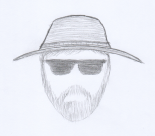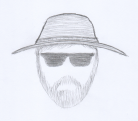
Sunset On Mt. LeConte
He was pacing back and forth on a small section of the North Kaibab Trail, 200 yards or so north of Phantom Ranch at the bottom of the Grand Canyon. As I drew nearer, he was talking out loud, gesturing occasionally to no one around him. The conversation concluded and as I passed him, he held up the smartphone and hit the “end call” button. He turned his attention to me saying, “Can you believe it? This is the only spot in the canyon where you can get a signal.”
As with any beautiful vista, one often shares the experience with others in quiet reverence as the moment is contemplated by each person’s reason for being there. Such is the case at Cliff Tops on Mt LeConte at sunset. There seems to be a profound respect shared by all who find themselves in the space and time of that moment. It is a reward for the effort of hiking several miles and a few thousand feet in elevation. However, there seemed to be a difference of opinion between two acquaintances in that the the one had no business saying what she said about the other; as the conversation was inadvertently shared with those around her during the moment the sky was on fire. Apparently, there is a good signal up on Mt. LeConte.
“Why did you come here?”
The only electronics I took on my AT thru hike in 1984 was a flashlight, a digital watch and a small 35 mm camera, which had to be supplied with film. I replaced the batteries in the flashlight twice. Navigation was accomplished by maps, a data book and the Philosopher’s Guide – all paper. And the trip was documented in a small spiral bound notebook with a ball point pen. The social network of the day was trail shelter registers, which were notebooks left by hikers providing news about trail conditions, AYCE restaurants in the next town, and who was hooking up with with whom.
The presence of technology in the backcountry has changed the experience across the spectrum and like any powerful capability, one must come to terms with when to use it and when not to. Despite the tone projected thus far, please know that I am not a Luddite. I embrace technology, researching and carefully choosing which devices offer value to me and which require more support than the benefits they return. The nature of this blog necessitates GPS technology to capture mileage, elevation and location. My growing love affair with photography has opened up a completely new realm of technology possibilities.
My latest backpacking adventure underscored just how dependent I have become on my gadgetry. Having run out of battery charge on my GPS watch AND my smartphone, the last leg of my hike was not documented anywhere but in my mind. No pictures, no voice recorder, no data. I hiked the complete 7 mile length of the Pretty Hollow Gap trail in about two hours. The next day, when I attempted to recount the section for posterity, I found I had little or no memory of the specifics of that hike. For a blog that relies on information and data, this is bad. The GPS, camera, and my voice reorder do in fact, help me remember details about each hike, solidifying the memory of them in my mind. I remember where the water is in most campsites and I remember where all the big trees are. I remember how many wet fords there are on each trail. This is all good.
But I also came to realize that the hike down Pretty Hollow Gap put me in a state of contemplative flow, an experience which I have come to long for in the wilderness. Without the constant awareness of checking the watch and recording where the switchbacks and stream crossings are, I was able to forget about time. I remember being aware of the morning, the bird songs, the coolness of the air. I don’t remember how steep the trail was and I don’t remember any stream crossings, although there has to be some. There was regret in not having the information to document my hike, but upon reflection, what seemed to matter more was the memory of the contentment of that morning’s experience. I reminded myself of the question –
“Why did you come here?”

Strider Out!


 Strider Out!
Strider Out!

 Strider out!
Strider out!

















